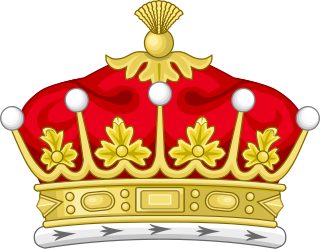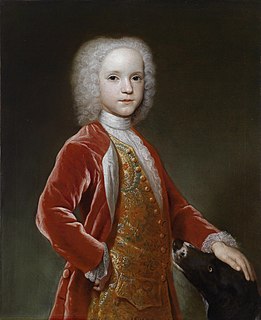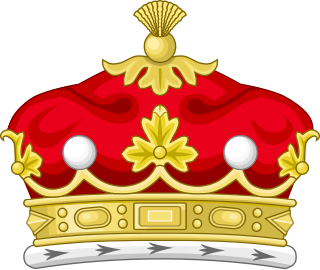 W
WMarquess of Alventos is a hereditary title in the Peerage of Spain, granted in 1761 by Philip V to José de Rojas, veintiquatro of Seville and knight of the Order of Calatrava.
 W
WBaron Boston, of Boston in the County of Lincoln, is a title in the Peerage of Great Britain. It was created in 1761 for the court official and former Member of Parliament, Sir William Irby, 2nd Baronet. He had earlier represented Launceston and Bodmin in the House of Commons. He was the son of Edward Irby, Member of Parliament for Boston, who was created a baronet, of Whaplode and Boston in the County of Lincoln, in the Baronetage of England on 13 April 1704. Lord Boston's son, the second Baron, was a Lord of the Bedchamber to both George III and George IV. The title followed the line of his eldest son, the third Baron, until the death of the latter's great-great-grandson, the eighth Baron, in 1972. The late Baron was succeeded by his third cousin once removed, the ninth Baron. He was the great-grandson of Rear-Admiral the Hon. Frederick Paul Irby, second son of the second Baron. Since 2007, the title is held by his grandson, the 11th Baron.
 W
WEarl De La Warr is a title in the Peerage of Great Britain. It was created in 1761 for John West, 7th Baron De La Warr.
 W
WEarl De La Warr is a title in the Peerage of Great Britain. It was created in 1761 for John West, 7th Baron De La Warr.
 W
WMarquess of Ripon, in the County of York was a title in the Peerage of the United Kingdom. It was created in 1871 for the Liberal politician George Robinson, 2nd Earl of Ripon.
 W
WDuke of Westminster is a title in the Peerage of the United Kingdom. It was created by Queen Victoria in 1874 and bestowed upon Hugh Grosvenor, 3rd Marquess of Westminster. It is the most recent dukedom conferred on someone not related to the British royal family.
 W
WDuke of Leinster is a title in the Peerage of Ireland and the premier dukedom in that peerage. The subsidiary titles of the Duke of Leinster are: Marquess of Kildare (1761), Earl of Kildare (1316), Earl of Offaly (1761), Viscount Leinster, of Taplow in the County of Buckingham (1747), Baron Offaly (1620) and Baron Kildare, of Kildare in the County of Kildare (1870). The viscounty of Leinster is in the Peerage of Great Britain, the barony of Kildare in the Peerage of the United Kingdom, and all other titles in the Peerage of Ireland. The courtesy title of the eldest son and heir of the Duke of Leinster is Marquess of Kildare. The Duke of Leinster is the head of the House of Kildare.
 W
WGeorge Bubb Dodington, 1st Baron Melcombe was an English whig politician who sat in the House of Commons from 1715 to 1761.
 W
WMarquess of the County of Bute, shortened in general usage to Marquess of Bute, is a title in the Peerage of Great Britain. It was created in 1796 for John Stuart, 4th Earl of Bute.
 W
WDuke of Leinster is a title in the Peerage of Ireland and the premier dukedom in that peerage. The subsidiary titles of the Duke of Leinster are: Marquess of Kildare (1761), Earl of Kildare (1316), Earl of Offaly (1761), Viscount Leinster, of Taplow in the County of Buckingham (1747), Baron Offaly (1620) and Baron Kildare, of Kildare in the County of Kildare (1870). The viscounty of Leinster is in the Peerage of Great Britain, the barony of Kildare in the Peerage of the United Kingdom, and all other titles in the Peerage of Ireland. The courtesy title of the eldest son and heir of the Duke of Leinster is Marquess of Kildare. The Duke of Leinster is the head of the House of Kildare.
 W
WViscount Scarsdale, of Scarsdale in Derbyshire, is a title in the Peerage of the United Kingdom. It was created in 1911 for the prominent Conservative politician and former Viceroy of India George Curzon, 1st Baron Curzon of Kedleston, who was created Earl Curzon of Kedleston at the same time and was later made Marquess Curzon of Kedleston.
 W
WEarl Talbot is a title that has been created twice in the Peerage of Great Britain. This branch of the Talbot family descends from the Hon. Sir Gilbert Talbot, third son of John Talbot, 2nd Earl of Shrewsbury. His great-great-great-grandson, the Right Reverend William Talbot, was Bishop of Oxford, of Salisbury and of Durham. His eldest son Charles Talbot was a prominent lawyer and politician. In 1733, he was raised to the Peerage of Great Britain as Lord Talbot, Baron of Hensol, in the County of Glamorgan, and then served as Lord High Chancellor of Great Britain from 1733 to 1737.
 W
WEarl Winterton, in the County of Galway, is a title in the Peerage of Ireland. It was created in 1766 for Edward Turnour, 1st Baron Winterton, who represented Bramber in the House of Commons. Turnour had already been created Baron Winterton, of Gort in the County of Galway, in 1761, and was made Viscount Turnour, of Gort in the County of Galway, at the same time as he was given the earldom. These titles are also in the Peerage of Ireland. Born Edward Turnour Garth, Lord Winterton was the son of Joseph Garth and his wife Sarah, daughter of Francis Gee and his wife Sarah, daughter of Sir Edward Turnour, Member of Parliament for Orford, elder son of Sir Edward Turnour, Speaker of the House of Commons from 1661 to 1671. His mother was sole heiress to the Turnor estates and on her death in 1744 he assumed by Royal licence the surname of Turnour.